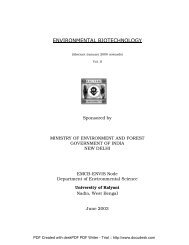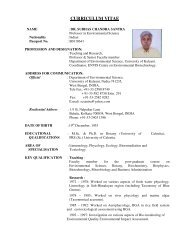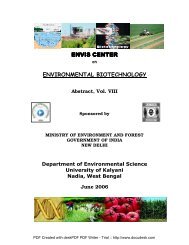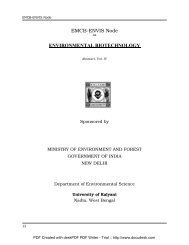EMCB-ENVIS Node ENVIRONMENTAL BIOTECHNOLOGY
EMCB-ENVIS Node ENVIRONMENTAL BIOTECHNOLOGY
EMCB-ENVIS Node ENVIRONMENTAL BIOTECHNOLOGY
You also want an ePaper? Increase the reach of your titles
YUMPU automatically turns print PDFs into web optimized ePapers that Google loves.
<strong>EMCB</strong>-<strong>ENVIS</strong> Centre<br />
Marine Resources Research Institute, 217 Fort Johnson Rd., Charleston, SC 29422, USA).<br />
Bioaccumulation and toxicity of fluoranthene in the estuarine oligochaete<br />
Monopylephorus rubroniveus. Ecotoxicology and Environmental Safety, 55(3) (2003),<br />
278-286.<br />
The tolerance of the estuarine oligochaete Monopylephorus rubroniveus to fluoranthene was<br />
characterized both in the presence and absence of ultraviolet (UV) radiation. Using waterborne<br />
exposures, the 72-h median lethal concentration (LC50) and median lethal dose (LD50) were 0.7<br />
(95% CI, 0.4–0.8) μg/L and 8.0 (5.6–9.6) μg/g worm dry weight, respectively, in the presence of<br />
UV radiation [UV-A=64.7±1.0 μW/cm 2 (mean±standard deviation)]. In the absence of UV<br />
radiation, little mortality was observed, even at the water solubility limits of fluoranthene<br />
(120.4 μg/L). Mean bioconcentration factors across all treatments was 10,893±2828. Using<br />
sediment exposures, little mortality was observed following 10 days at concentrations as high as<br />
3912 μg fluoranthene/g sediment dry weight in both the presence of UV radiation (UV-<br />
A=108.4±1.3 μW/cm 2 ) and its absence. Bioaccumulation of sediment-associated fluoranthene<br />
was comparatively high and varied little among the five sediment treatments. The results of the<br />
present study demonstrate that M. rubroniveus is (1) sensitive to waterborne fluoranthene in the<br />
presence of UV radiation and (2) highly tolerant of fluoranthene in the presence of sediment,<br />
despite the ability to bioaccumulate fluoranthene to comparatively high levels. These findings<br />
suggest that those environmental factors which could potentially increase their exposure to UV<br />
radiation need to be considered when assessing the overall risk of fluoranthene to M.<br />
rubroniveus.<br />
K. Borgå, M. Poltermann, A. Polder, O. Pavlova, B. Gulliksen, G. W. Gabrielsen, J. U.<br />
Skaare. (Norwegian Polar Institute, N-9296 Tromsø, Norway. Norwegian College of Fishery<br />
Science, University of Tromsø, N-9037 Tromsø, Norway. Norwegian School of Veterinary<br />
Science, PO Box 8146, N-0033 Oslo, Norway. UNIS, PO Box 156, 9170 Longyearbyen,<br />
Norway. National Veterinary Institute, PO Box 8156 Dep., N-0033 Oslo, Norway).<br />
Influence of diet and sea ice drift on organochlorine bioaccumulation in Arctic iceassociated<br />
amphipods. Environmental Pollution, 117(1) (2002), 47-60.<br />
The drifting sea ice has been suggested as important in the transport and concentration of organic<br />
matter and pollutants in the Arctic. We collected sea ice-associated amphipods in the marginal<br />
ice zone north of Svalbard and in the Fram Strait in September 1998 and 1999 to assess<br />
contaminant accumulation in ice-associated organisms. Organochlorine concentrations increased<br />
from the more herbivorous Apherusa glacialis to the more carnivorous Gammarus wilkitzkii and<br />
the more necrophagous Onisimus spp. The relative contribution of compound classes to the sum<br />
of organochlorines differed between the amphipod families, with a higher relative contribution of<br />
hexachlorocyclohexanes (HCHs) in A. glacialis. The composition of the compound classes<br />
HCHs, chlordanes and dichlorodiphenyltrichloroethanes (DDTs) was similar between the<br />
amphipod families, whereas the profiles of polychlorinated biphenyls (PCBs) differed. The<br />
occurrence of organochlorines differed spatially, with higher α-HCH concentrations in<br />
amphipods from the Fram Strait in comparison with amphipods collected north of Svalbard. This<br />
could be related to the sea ice drift route, since sea ice in the Fram Strait had a drift route across<br />
the central Arctic Ocean, while the sea ice north of Svalbard had a western drift route to the<br />
sampling stations. Even though marine invertebrates have direct uptake by passive diffusion of<br />
contaminants across their gills, our results imply that the species' ecology such as diet is<br />
important in the bioaccumulation process of organic pollutants. In addition, the results show that<br />
sea ice drift route influences the concentrations of organochlorine pollutants in ice-associated<br />
organisms.<br />
30<br />
PDF Created with deskPDF PDF Writer - Trial :: http://www.docudesk.com







